History of needle development(Fukuhara Needle Co., Ltd.)
| 1948 | Manufacturing of knitting needles started. | ||
| 1975 | All knitting needles were changed to plate-needles from wire-needles. | ||
| 1984 | Compound needle was developed. | ||
| 1986 | Butt of R chamfering method was introduced. | ||
| 1988 | PRESSED LATCH SHEET was developed. | ||
| August,1990 | Laser welding of Latch-rivet was started. | ||
| 1996 | Open hook countermeasure needle was developed. | ||
| 1998 | New hardening technology was introduced. | ||
| January,2000 | Four dimensionally pressed needle was developed. | ||
| 2001 | Production of transfer needles began. | ||
| December,2001 | Dimensional accuracy for needles was revised. | ||
| 2002 | Fine gauge needle for single-knit machines was developed.(46G) | ||
| 2004 | Needle with strengthened hook was developed. | ||
| November, 2005 | E-NEEDLE® was developed. | ||
| November, 2007 | Improved plating needle was developed.(Modified shaped hook) | 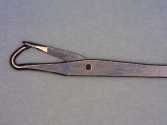 |
|
| January, 2008 | Ultra-fine gauge needle for single-knit machines was developed. (60G) | 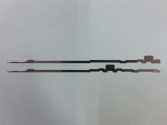 |
|
| 2009 | Ultra-fine gauge needle for double-knit machines was developed. (50G) | 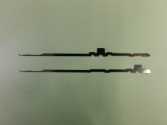 |
|
| 2010 | New latch was introduced. | ||
| 2011 | Pressed tip needle was developed. | 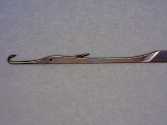 |
|
Needle trouble and causes
Latch breakage |
||
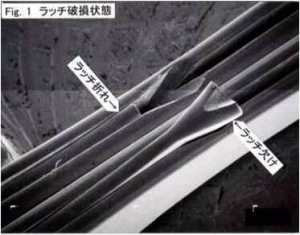 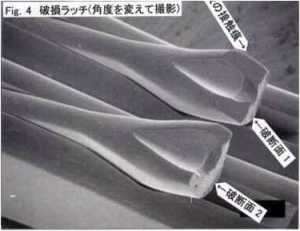 |
||
| Causes | High-speed, tight-stitch, contact with Y/C, rust, wear, etc. | |
Latch wear |
||
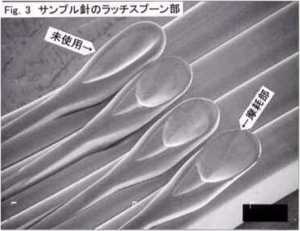 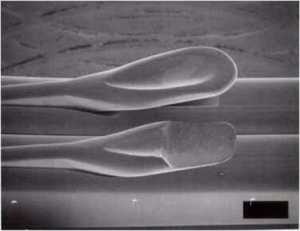 |
||
| Causes | Poor quality yarn, oil-shortage, high-yarn tension,contact with Y/C, etc. | |
Latch rivet wear / loose latch |
||
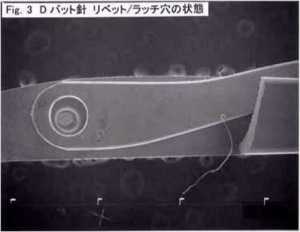 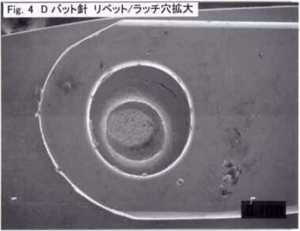 |
||
| Causes | Poor quality yarn, oil-shortage, high-yarn tension, etc. | |
Hook breakage |
||
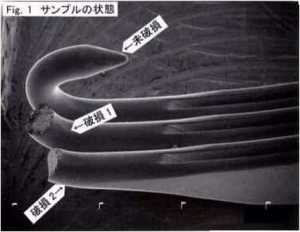 |
||
| Causes | Shock wave from high-speed knitting, excessive yarn tension, lint accumulation or slabs, fabric load up, etc. | |
Hook wear |
||
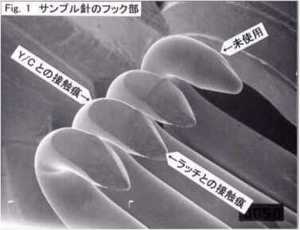 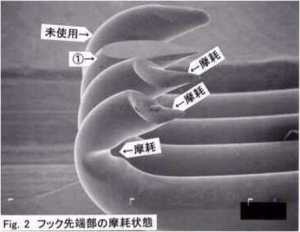 |
||
| Causes | Poor quality yarn, oil-shortage, high yarn-tension, contact with Y/C, etc. | |
Lint accumulation |
||
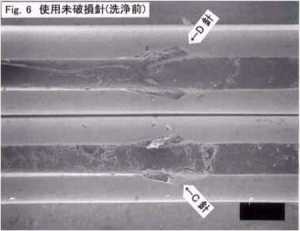 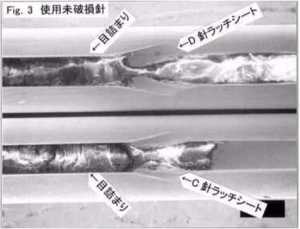 |
||
| Causes | Poor quality yarn, insufficient-air-blowing, excessive wax, insufficient maintenance, etc. | |
Butt wear |
||
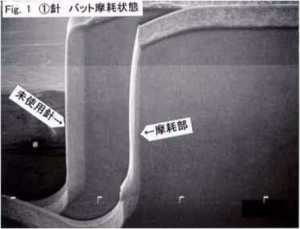 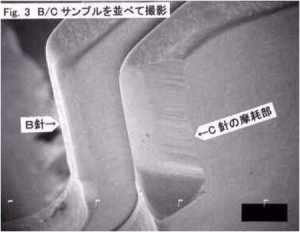 |
||
| Causes | Oil-shortage, bad (abrasive) cam-surface, high-yarn tension, poor quality yarn, insufficient maintenance, etc. | |
Butt Breakage |
||
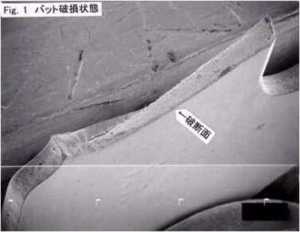 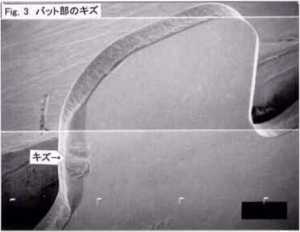 |
||
| Causes | Oil-shortage, bad (abrasive) cam-surface, high-yarn tension, poor quality yarn, insufficient maintenance, etc. | |
Cheek Chipping |
||
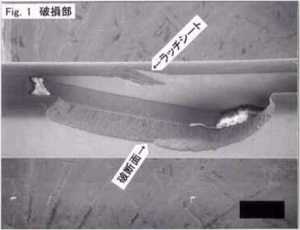 |
||
| Causes | Inappropriate latch seat, etc. | |
Latch bending, Latch going into hook |
||
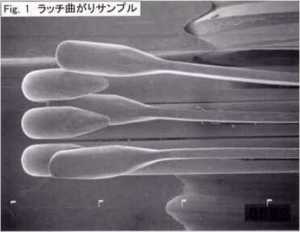 |
||
| Causes | Operator errors (after press-off, etc), contact with Y/C, etc. | |
Filamentation |
||
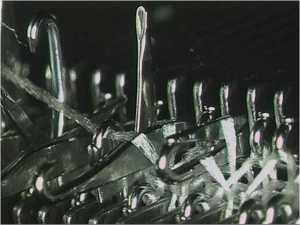 |
||
| Causes | Burr on latch slot edge, insufficient trapping clearance, etc. | |
Opened Hook |
||
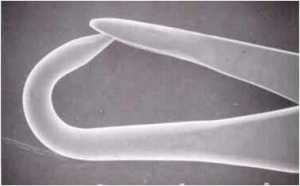 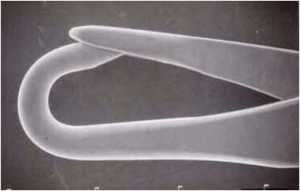 |
||
| Causes | Inappropriate yarn-count, small hook (larger hook needed), insufficient material strength, etc. | |
Swan neck |
||
| Causes | Excessive take-up tension | |
Oil lines |
||
| Causes | Excessive oil, needle bending | |
Needle lines |
||
| Causes | Yarn movement not smooth, poor needle quality, wear, lint accumulation, etc. | |
Sinker Wear |
||
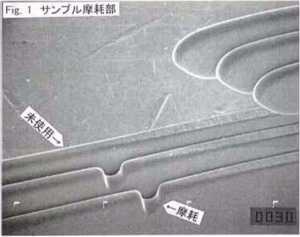 |
||
| Causes | Poor quality yarn, excessive yarn tension, etc. | |
The wear due to natural fiber
| 1.Needle Surface Wear | ||
| Wear resembling scrapes will appear on the needle surface when yarns containing abrasive particles are used. | ||
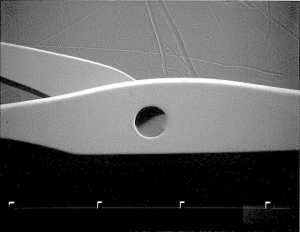 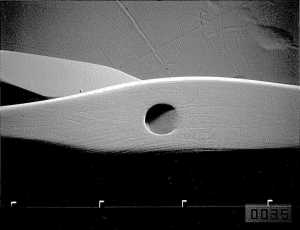 Fig.1Needle surface before use (magnified 35x) Fig.2Needle surface after open-end yarn is knitted. (magnified 35x) |
||
| 2.Hook and latch wear | ||
| Abrasive particles which adhere and accumulate at the latch spoon area, et cetera will facilitate wear on all areas which make contact when the latch closes. | ||
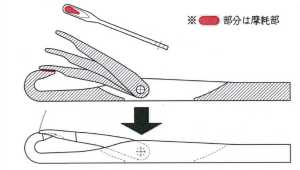 Diagram1 Hook and latch wear |
||
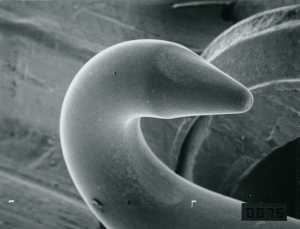 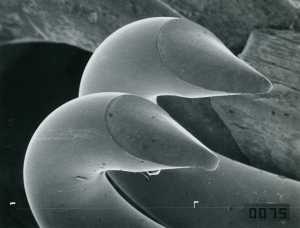 Fig.3 Hook before use x75 Fig.4 Worn hook x75 |
||
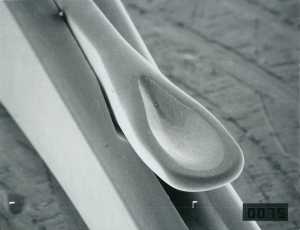 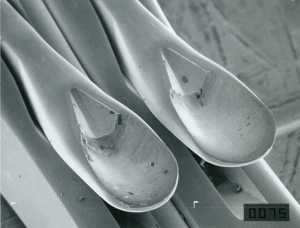 Fig.5 Latch spoon before being used x75 Fig.6 Worn latch spoon x75 |
||
| 3. Latch body and slot wear | ||
| Abrasive particles adhere to the latch body and find their way into the latch slot. This facilitates wear on both the body side and slot side during the movement of the latch when it opens and closes. | ||
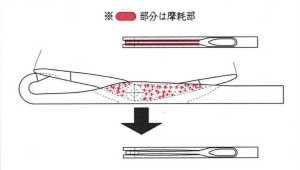 Diagram2 Latch body and slot wear |
||
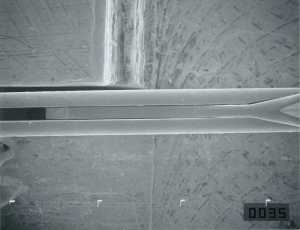 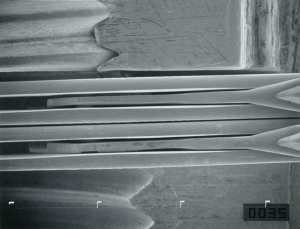 Fig.7 Latch body and slot before use x35 Fig.8 Worn latch body and slot x35 |
||
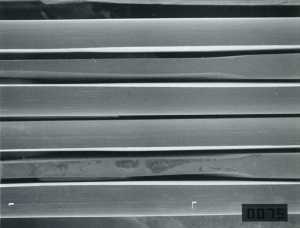 Fig.9 Worn area magnified x75 |
||
| 4.Latch hole and rivet wear | ||
| Abrasive particles inside the latch slot will facilitate wear in the area around the revolving axis (latch rivet) of the latch. | ||
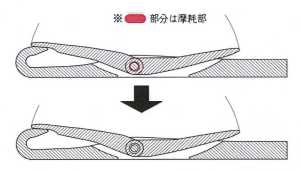 Diagram3 Latch hole and rivet wear |
||
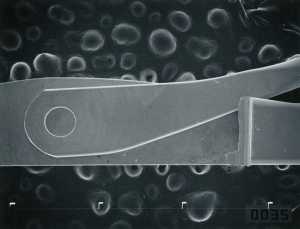 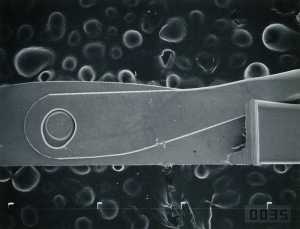 Fig.10 Latch hole and rivet area before use x75 Fig.11 Worn latch hole and rivet area x75 |
||
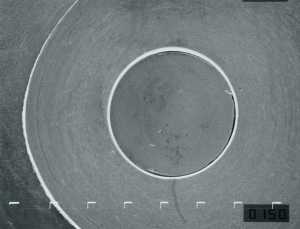 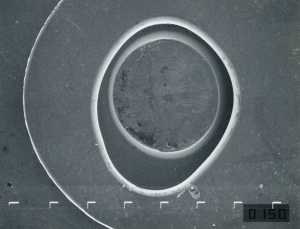 Fig.12 Latch hole and rivet area before use x150 Fig.13 Worn latch hole and rivet area x150 |
||
| 5.Latch back and seat wear | ||
| Abrasive particles which adhere and accumulate at the latch seat area will facilitate wear on all areas which make contact when the latch opens. | ||
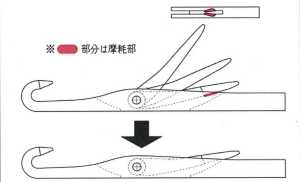 Diagram4 Latch back and seat wear |
||
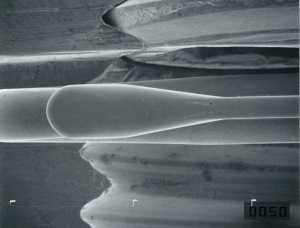 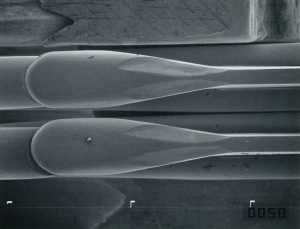 Fig.14 Latch back before use x50 Fig.15 Worn latch back x50 |
||
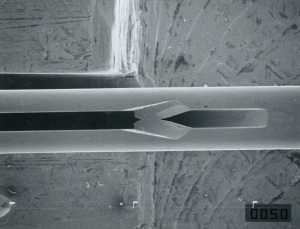 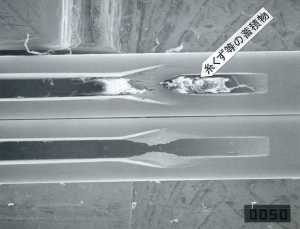 Fig.16 Latch seat before use x50 Fig.17 Worn latch seat x50 |
||
| 6.Abrasive fibers (impurities) found in natural fibers | ||
| Abrasive particles (impurities) have a tendency to adhere to natural fibers found in open-end yarn, et cetera. Using these sorts of yarns will bring about wear in various areas on the needle | ||
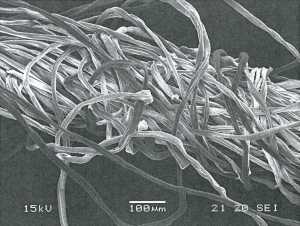 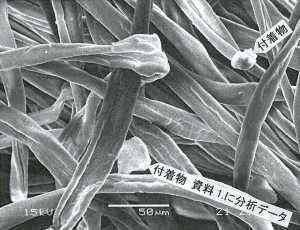 Fig.18 The surface of open-end yarn x150 Fig.19 Magnified x500 |
||
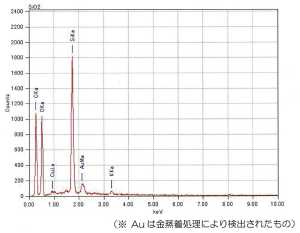 【Data1 Analysis of abrasive objects adhered to yarn】 |
||
| Based on the results of the analysis, the object adhered to the yarn in
figures 18 and 19 is thought to be SiO2 (silica). Analyzing objects adhered to yarn in this way can show how these objects were likely on the raw cotton from the time it was harvested. It is often the case that these objects are found to contain highly abrasive impurities. |
||